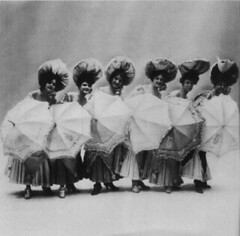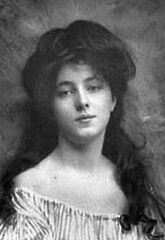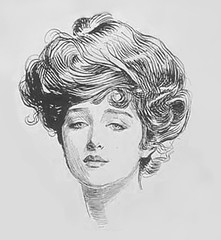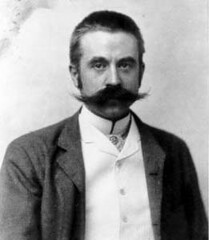Thu 25 Sep, 2008
FLORANET
Comments (1) Filed under: Hair Net PackagesTags: cocaine, criminally insane, Evelyn Nesbit, Florodora girls, Harry K. Thaw, morphine, pistol, Stanford White, whip

Floranet c. 1920
Advertising reflects its time, and the themes and designs are often derived from popular culture. Who hasn’t heard a pop song in a car commercial on TV? Things weren’t much different 80 years ago. The concept for the Floranet shown above was most likely a result of the New York revival of the musical Florodora in 1920. The play had its original debut on the London stage in 1899, and was one of the first successful musicals at the dawn of the 20th century.

Floradora Girls
When Florodora moved from the London stage to Broadway in 1900 it was a runaway hit. The women who played in the chorus were dubbed the Florodora Girls, and they were so popular that no fewer than 70 women rotated into, and out of, the first run production in New York. Many of the women were courted by wealthy young men whom they later married.
Not all of the Florodora girls would go on to have successful relationships with the men that they met. The most famous of them was Evelyn Nesbit.

Evelyn Nesbit
Evelyn Nesbit was born on Christmas day in 1874 in Tarentum, a small village near Pittsburgh. Her family wasn’t well off — so when her father, a struggling attorney, died at age 42 they were left nearly destitute. Evelyn was a beautiful girl, and it wasn’t surprising when she came to the attention of artists in her hometown. She was soon earning enough as a model to support her family. The Nesbits moved from Philadelphia to New York City in 1893 where Evelyn continued her career. Among the artists who hired her was famed illustrator Charles Dana Gibson. It is said that Evelyn was the inspiration for his famous Gibson Girls.

Gibson Girl
While playing in the chorus of Florodora, Evelyn caught the eye of millionaire architect, notorious womanizer, and grower of an extraordinary mustache, Stanford White. White was 47, and Evelyn only 16; however, it wasn’t long before the married White was pursuing the teenaged chorus girl. Evelyn’s mother was undoubtedly swayed by White’s fortune because she turned a blind eye to Stanford’s reputation and his married status, and encouraged her daughter’s relationship with “Stanny”.

Stanford White
White had designed an opulent apartment in New York City, complete with many strategically placed mirrors and the most intriguing amenity of all, a red velvet swing suspended from the ceiling. White loved nothing better than to push his nude young paramours in the swing!
While Evelyn’s mother was conveniently out of the city, White made his move. He plied the young beauty with champagne, took suggestive photographs of her in a yellow silk kimono, and then he took her virginity. Of course the evening ended with Evelyn perched upon the red velvet swing. White would pursue other young women, and Evelyn would begin dating the actor John Barrymore [yes, Drew is related].

Harry K. Thaw
The stunning chorine finally became involved with Harry K. Thaw. Thaw came from money – his father was a coal and railroad baron. She married Thaw, who was no less kinky in his sexual habits than White had been. Thaw had a history of violence and drug use. He had a rapacious appetite for cocaine and morphine, both of which he injected, and he was in the habit of carrying a pistol and a whip.
Evelyn was obviously attracted to older “bad boys”; however, Harry wasn’t just bad, he was mad as a hatter. Perhaps fueled by cocaine induced paranoia, Thaw’s jealous obsession over Evelyn’s previous relationship with White finally drove him to confront the architect in the rooftop restaurant at Madison Square Garden. In full view of the patrons, the whip cracking, pistol packing Thaw produced a gun and fired three times into White’s face, killing him. Some of the diners thought that the shooting was part of the play they were attending, and others thought that it might be part of an elaborate practical joke (practical jokes were de rigeur in society at the time). Holding the weapon above his head, Thaw calmly walked to the elevator to meet Evelyn.
Harry was shortly arrested for the slaying and put on trial. The jury deadlocked at his first trial. By offering her money and the promise of a divorce, Harry’s mother convinced Evelyn to testify during his second trial that she’d been raped by White. In the courtroom, all eyes were on Evelyn as she told tales of the red velvet swing. Evelyn was a compelling witness on Harry’s behalf – he was found not guilty by reason of insanity and sentenced to Matteawan State Hospital for the Criminally Insane. Following the trial Evelyn got the divorce, but none of the money she’d been promised. Harry’s ungrateful mother reneged on their deal and cut her off without a cent.
Even though Thaw was allowed almost total freedom at Matteawan, he escaped after a few years and fled to Canada. He was eventually extradited back to the United States, and in a second sanity trial he was determined to be sane. Throughout the remainder of his life Thaw would have brushes with the law, and questions regarding his sanity would continue to arise. Thaw died of a heart attack in 1947.
There have been many references to Evelyn Nesbit in popular culture over the years. Joan Collins played her in the 1955 film The Girl in the Red Velvet Swing. Evelyn also became a character in E.L. Doctorow’s novel Ragtime.
The infamous “Girl in the Red Velvet Swing” died on January 17, 1967 in a Santa Monica, CA nursing home.


Gordon B. Chamberlain says:
Correct spelling appears to be “Florodora” with an O, though “Floradora” certainly sounds better. Check the original programs shown at Wikipedia.